
Over the last decade, the world of (online) marketing has changed. There used to be a time when you could just advertise at random places, and you could expect a steady stream of click-throughs to your website.
The very first banner ever even had a Click Through Rate (CTR) of 44%. Nowadays, companies are jumping through the roof when they are 0.44%, with an average CTR at the moment of 0.17%, according to benchmarks by DoubleClick.
Today’s consumers have changed. They are either “banner blind” and mentally blocking out the advertisements on the website or have ad-blockers installed. They look beyond logos, overlook your promotions, and won’t sign up for your newsletter. Today’s consumers only need the information when they want it, delivered to them in the format they want it.
And with as many as 81% of consumers conducting research before making a purchase, it’s fair to say that people today have much more to say about who they buy from than ever before.
If you’re broadcasting your products or services to your target audience, good luck trying to sell to them. Consumers want to start a dialogue with you and don’t like being told what to choose and what to buy. So how do you make your potential customers notice you?
You do this by being helpful, hence the birth of Content Marketing.
Content marketing is just solving the same problems that your product solves through media you create and promote.Click To TweetBut with everybody diving into Content marketing nowadays, it becomes more and more difficult to cut through the noise and get your content delivered to your potential customers.
You need to deliver content that’s relevant to them based on the behavior they have at each stage of the customer’s journey.
And what happens next?
While different Content Marketing Strategies might have different purposes (lead generation, brand awareness, website traffic, etc.), the end goal should always be to increase revenue and drive more business.
In the old days, the sales team used to shoulder the sales funnel or customer’s journey, but nowadays, the customer’s journey has transformed into more touchpoints across different channels. Quality content provides more than just a great way for marketers to connect with new audiences; it also helps your sales department better. With the right content, your sales staff can:
- Be better prepared for their sales conversations;
- Get better-qualified leads
- Gain access to selling tools to engage more effectively
- Learn more about their audience through analytics
Table of Contents
- The Five Stages Of Every Customer Journey
- Different content for different stages of the customer journey
- The best content for each stage of the customer journey
- The best content for the awareness stage
- The best content for the consideration stage
- The best content for the conversion stage
- The best content for the loyalty stage
- The best content for the advocacy stage
- How can Content Marketing help and boost your sales?
The Five Stages Of Every Customer Journey
Awareness
Before any customer ever comes to the point of wanting to buy from you, they need to know that you exist. If your potential customers don’t know that your company or your products exist, they will never buy from you.
This seems pretty logical, but there are many companies out there or startups that think that the moment they launch, hundreds or thousands of customers will come running toward them, ready to buy.
If you did not do any marketing before, how can they know you’re open for business? Companies must market themselves and create awareness before hoping for any sales.
Consideration
The next step in the journey is the “consideration”. Your potential customers are aware of your existence, and because of your brilliant product offering, they might even consider buying from you.
Based on the fact that your product or service is solving a real problem for them if the price is fair and if the pain is big enough that it needs to be resolved right now, they will decide whether to buy or not.
Marketing also plays a significant role in this part of the journey and can often be the tipping point that makes someone want to buy from you.
Look at a scenario of two restaurants, for example.
Every day on your way home, you pass both of them. You’re clearly passed the journey’s first stage, and you are aware of them.
Now, imagine one of them placing a sign outside showcasing their delicious food and talking about a promotion that week.
Which restaurant are you more likely to walk into?
The same thing holds for online. You might tinker with the thought of buying something, you’ve read reviews, you’ve read content from that company, and at the moment you’re almost ready to buy, you’re retargeted to help you hop on to the next step of the journey.
An excellent example of this is this story from Justin Veenema, who will for sure be buying a BoostedBoard right now!
Conversion
Yeah, high five! You’ve made the sale!
Now it is up to you to not only deliver a great product or service, but you have to provide a fantastic experience.
Delivering that fantastic experience is all part of the marketing and branding of your company. This will not only affect your brand, but it will also affect whether somebody will become an advocate for you and your brand.
Loyalty
The moment someone puts their wallet away again after purchase, that is the time when they will first decide how they feel about what they just bought.
Many businesses try to deliver products that will leave a great feeling behind with the people that just bought into their product or service offering, and so should you.
No business wants to be the reason that people feel “buyers’ remorse” because that will lead down the negative spiral of cancellation of your service or return of your product (if you’re lucky, it might be even worse and result in negative reviews on public places).
(Content) Marketing can be difficult during this phase, but it can help turn your customers into a loyal following if done correctly and innovatively.
Think of things like “explainer” video’s what is happening now you have ordered. Coolblue, a Dutch company, does a great job with this and offers secret overnight shipping as they do at Zappos to provide that extra bit of delight.
If your newly found customers have a great experience starting straight after the moment of purchase with your product, they will quickly move on to the next phase of the customer’s journey and become any company’s dream customers.
Advocacy
Having brand advocates is the goal of any business’s marketing program. Make your client so happy and delighted with your product or service that they not only purchase (and re-purchase) from you but also start referring you to everyone they know who might have the same need.
Moving someone all the way through your customer’s journey is no guarantee. However, someone will become a brand advocate or even wants to stay one when they are already one. You need to pay close attention to your marketing and ensure you’re able to ensure that all your customers are satisfied and that their needs are being met.
For some companies, this must be done by always innovating and developing new products, like Apple and Google. For others, it means consistently wowing their customers with fantastic customer service like Zappos.
Some others offer loyalty programs. Whatever you do, you should never take your (most loyal) customers for granted because as soon as you lose a client, all the effort and money spent in making them a customer in the first place has gone to waste.
Different content for different stages of the customer journey
As you can imagine, with the different stages come different types of content.
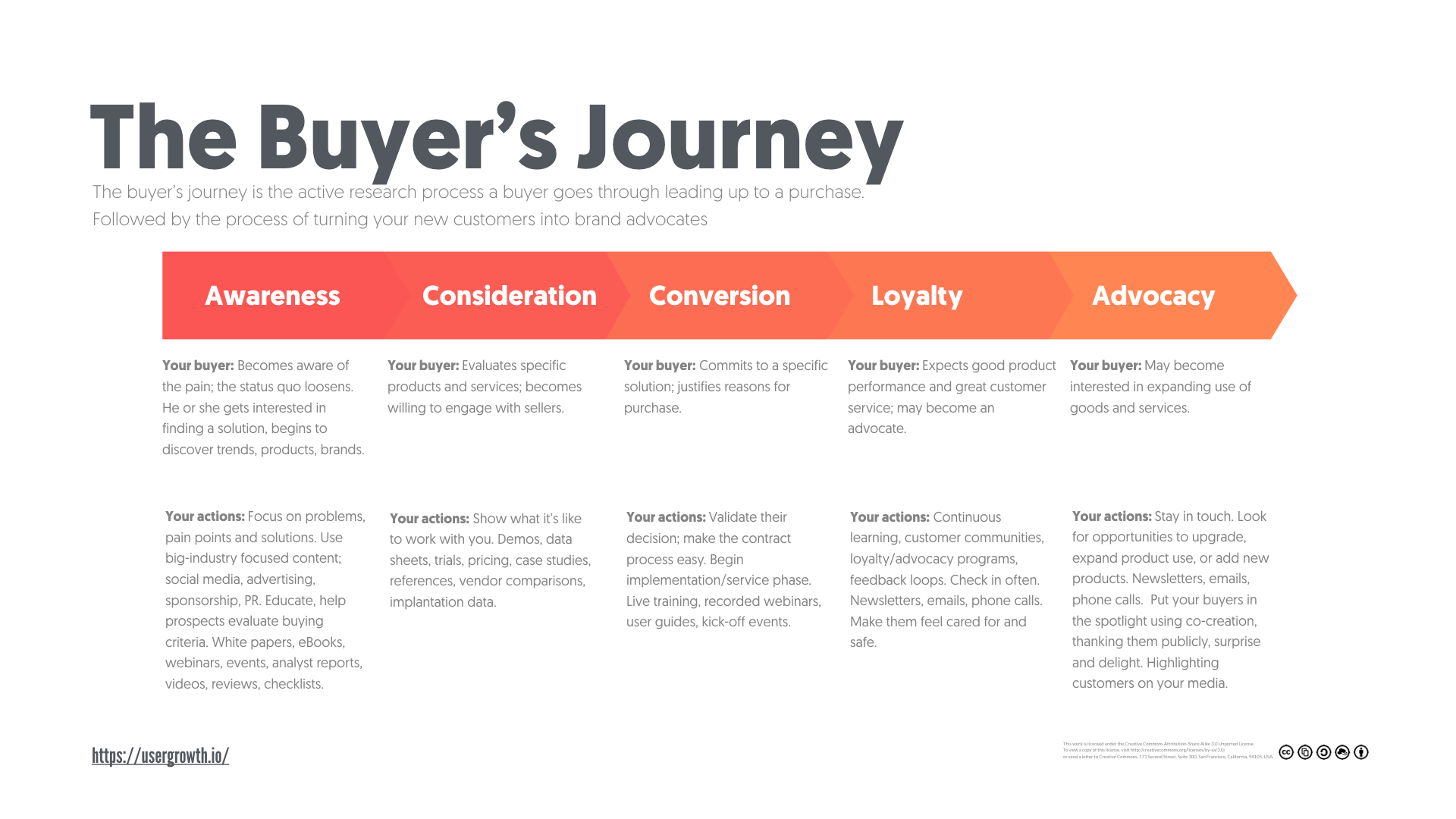
People are searching for different things.
For example, people buying a new washing machine are first searching for things like “the best washing machines of 2023” or “the best large capacity washing machines of 2023”. When they choose which size of washing machine they want, they start searching for more actionable like “best eco-friendly large-capacity washing machines” or “Miele vs. Samsung.”
Let’s have a look at the different stages and how this relates to the different types of content they are looking for.
In the awareness stage, people need to become aware of their pain, and when they do, they get interested in finding a solution and begin to discover trends, different products, and brands.
In the consideration stage, people start the evaluate specific products and services. They become willing to engage with potential sellers to solve their pain.
In the conversion stage, they want to commit to a specific solution. They want to find reasons that justify their purchase.
During the loyalty stage, your new customer expects good product performance and excellent customer service.
And finally, in the advocacy stage, they want to be nurtured, and they want to be kept informed about new products or services that could enhance their experience.
So where to start mapping your (existing) content for the customer’s journey?
- First, create a list of questions your customers are asking at each stage of their buying cycle;
- Then, audit your existing content and determine where it fits into the funnel;
- Next up, identify the gaps. Where does your content fall short of delivering valuable answers?
- Make a list of content that will help fill in these gaps, taking into account keyword analysis to identify the different sets of keywords that go with these topics;
- Get to work 😉
The best content for each stage of the customer journey
These different stages and different types of questions for each stage also result in various types of content.
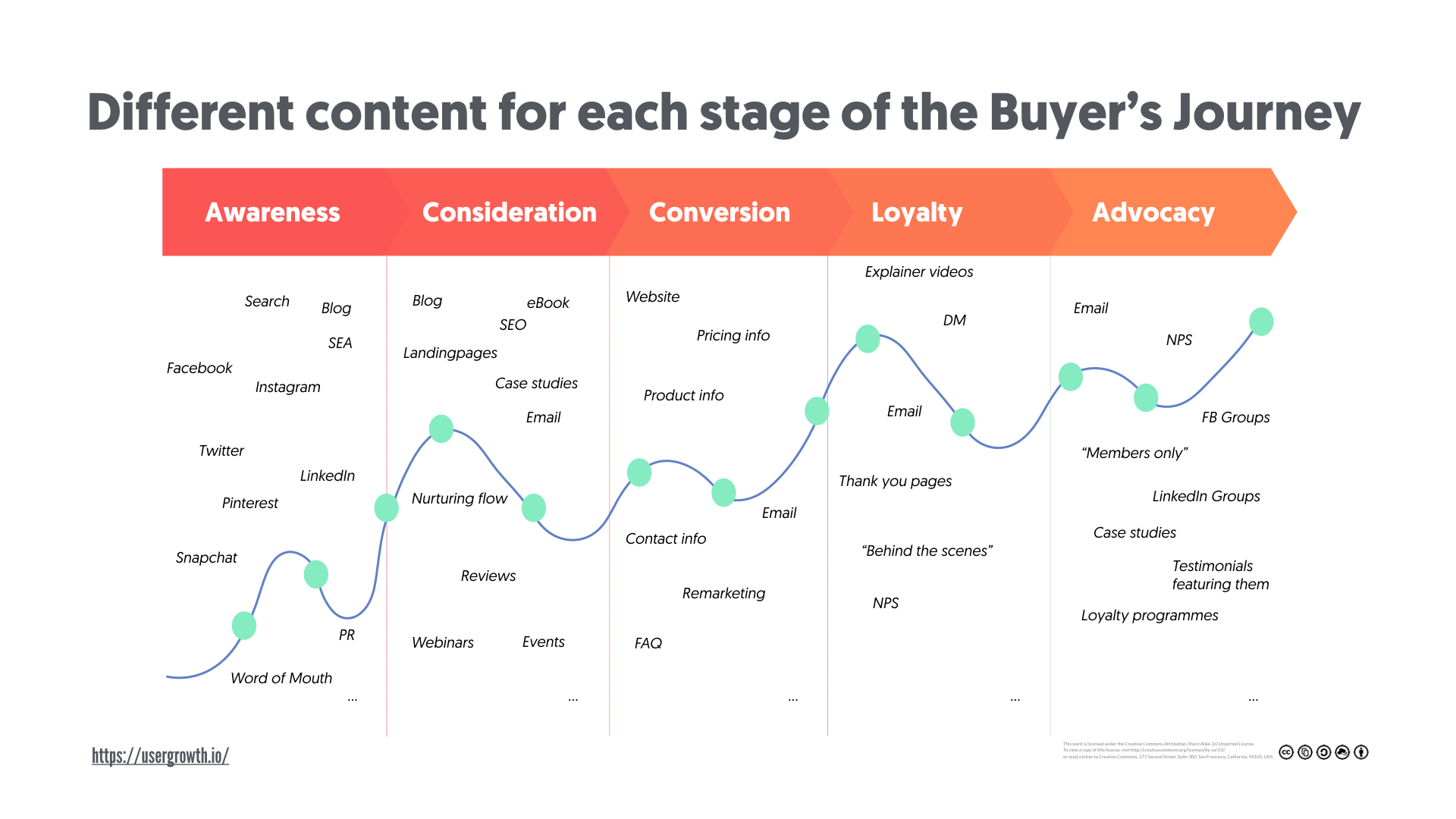
So let’s look at the types of content you can use for the best results.
The best content for the awareness stage
Since your buyer is just entering the market, the content for this stage needs to be a light read that whets the buyer’s appetite.
And since buyers at this stage are not yet highly qualified leads, your job is to relay information easily, concisely, and relatable manner.
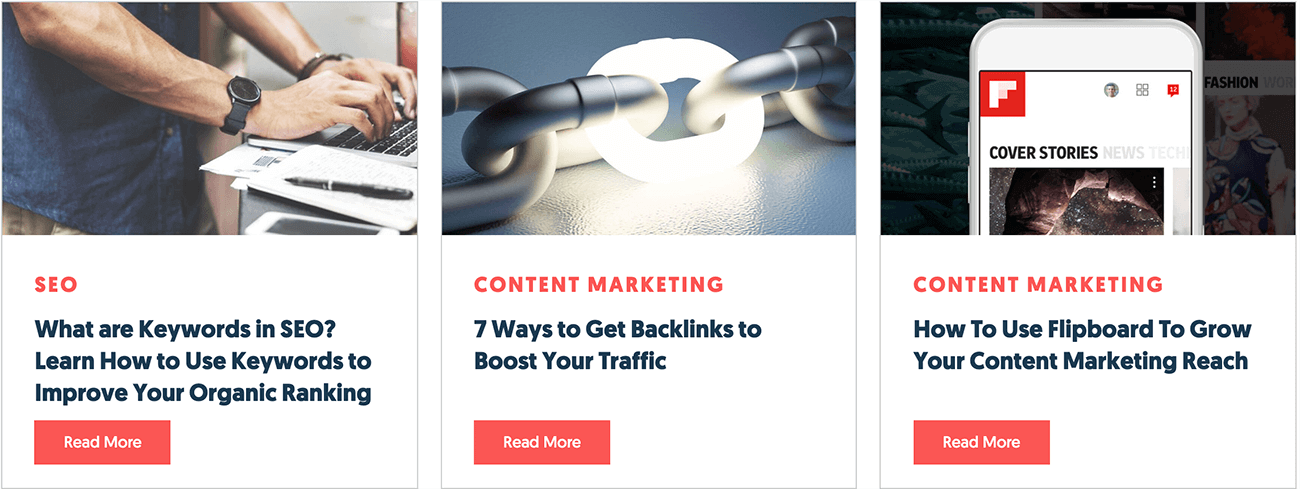
The goal of the blog content at this stage is to attract potential buyers, give something of value to them for free, and allow them to connect with your brand through social media or email marketing.
Some types of content you can use at this stage:
- Blog posts – “How to solve problem Y”
- Blog post – “What does ABC costs?”
- Blog posts – Answering questions from your customers
- Video – “How to do XYZ”
- E-book – “A simple strategy to achieve ABC”
- Infographic – “10 tips to achieve XYZ”
- Guides – “The ultimate guide to topic X”
- Social Media – Different types of lightweight content for people to get to know your brand and company on Facebook, Instagram, LinkedIn, and wherever your customer is.
The best content for the consideration stage
The Consideration stage is a crucial time for both you and the buyer. Not only is the buyer trying to figure out whether your product or service is right for them, but you also need to find out whether they fall into your true target audience, whose genuine interests really match your offering.
In essence, your potential buyer at this stage needs to be convinced that you want more than just their money, and the only way you can do so is by producing content that shows how you stand out from the pack.
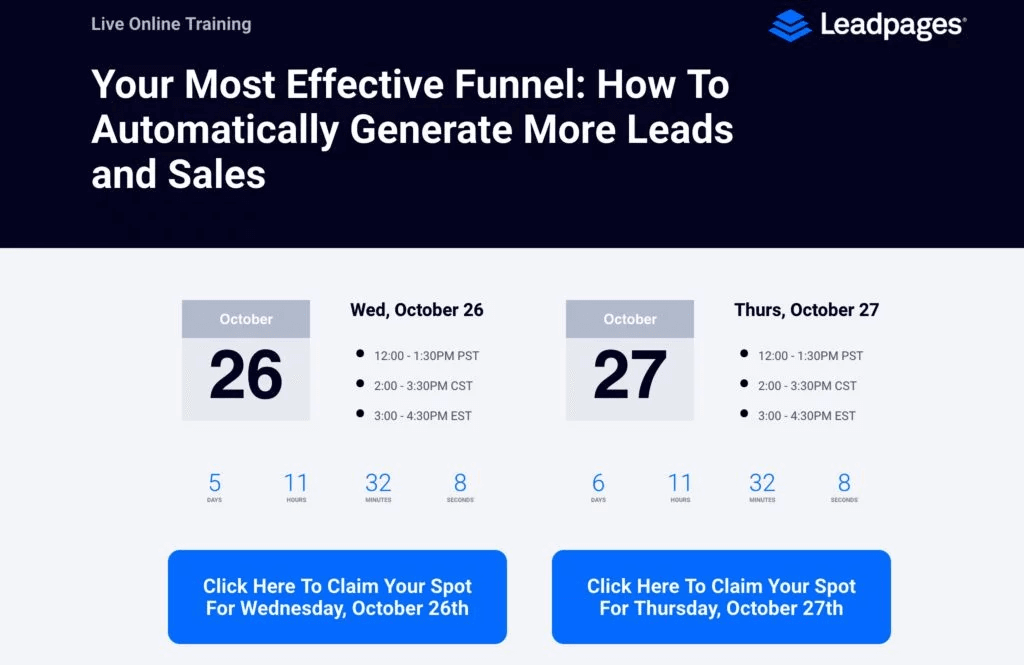
Here’s how it can be done:
- Blog post – “How solution X solves problem Y”
- Blog post – “How to calculate the ROI for solution X”
- Video – “How to integrate our solution X with software XYZ”
- E-book – “5 simple steps to implementing solution X”
- Guides – “How to calculate savings usings solution X”
- Webinars – “How to use solution X for your business”
But also digging a bit deeper for those people that are almost ready to start buying:
- Case studies “Customer case studies using solution X”
- Videos – “Customer Testimonials”
- Blog post – “Feature comparison solution X with competitors X, Y and Z”
- 3rd party industry report – “Top 10 industry solutions for problem Y”
- Studies – “ROI calculation after a successful implementation”
The best content for the conversion stage
The conversion stage is when your buyer is finally ready to grab that credit card and make the purchase. No pressure, but the content at this stage is what can make or break their decision to make that coveted “Buy Now” click.
Consumers and businesses today love personalization and interaction, which is why it’s essential for you to give them the perfect blend of both. The content you create should not just be highly customized, but it should also be persuasive enough to ensure you close the deal.
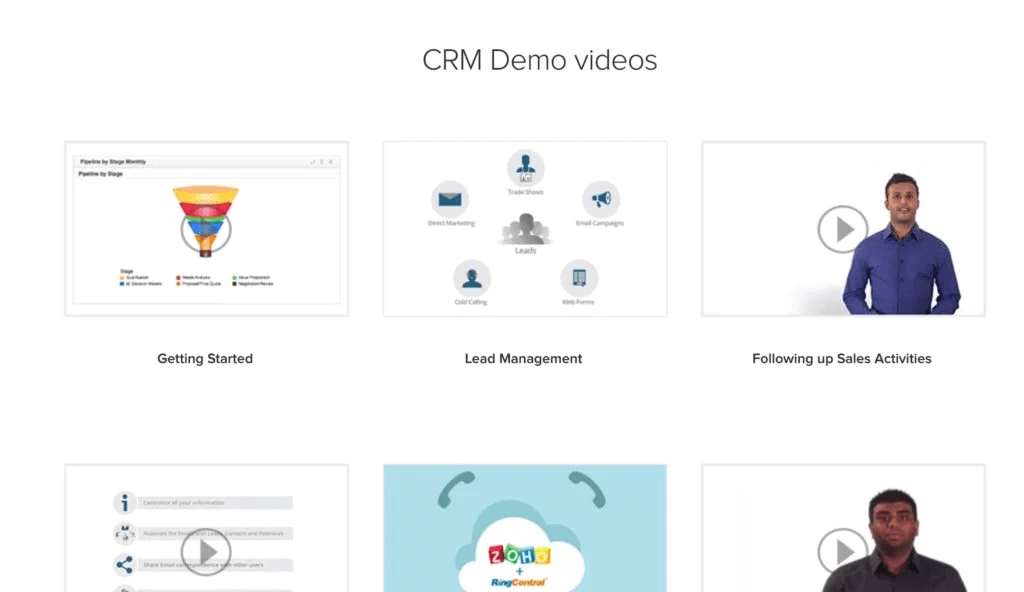
Here are some of the types of content you could use:
- Blog post – “Top 10 questions our customers ask about Y”
- FAQ – “Guide to doing business with us”
- Guide – “How to implement solution X”
- Video – “How to integrate solution X into your business”
- Webinars showing demos of the product
- Free trials allow your potential customer to interact with your product itself just enough for them to understand that they want it in their life.
The best content for the loyalty stage
For many businesses, the customer’s journey ends when a purchase is made, missing out on many opportunities to get repeat purchases, referral sales, and positive word of mouth.
The key to growing your business is convincing customers to buy again.
Customer lifetime value is a term that describes how much your customer is worth to your business from their first purchase to when they stop spending on your product or service. It’s an important metric to track, considering research has shown that profit is maximized in this stage.
Specifically, in a study done by Harvard Business Review, it is stated that increasing customer retention by just 5% can boost a company’s profits by nearly 100%:
Customer defections have a surprisingly powerful impact on the bottom line.
They can have more to do with a service company’s profits than scale, market share, unit costs, and many other factors usually associated with competitive advantage.
As a customer’s relationship with the company lengthens, profits rise. And not just a little. Companies can boost profits by almost 100% by retaining just 5% more of their customers.
Happy customers spend more on your service and are likelier to tell their friends about you.
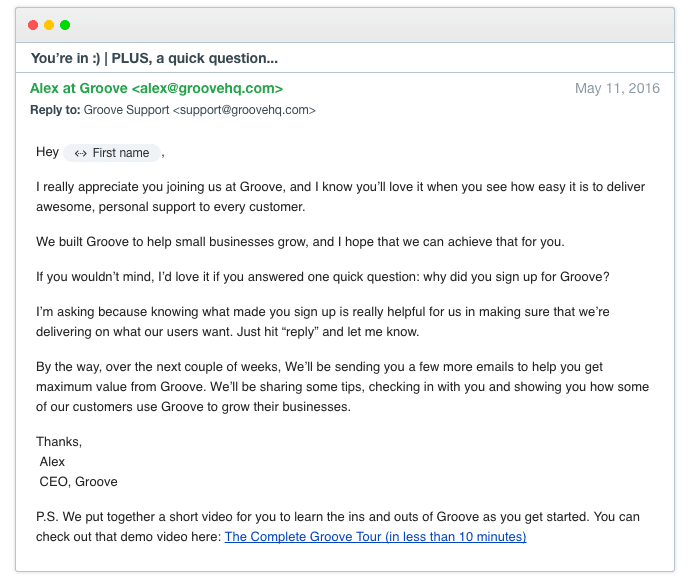
So what types of content can you produce to keep your new customers happy?
- Having a (public) helpdesk available at all times, like a forum or using software like Zendesk
- In-app messages, guiding them through their first steps
- Onboarding emails
- Walkthroughs on how to achieve certain things with your product
- Product-focused blog posts
- Surveys to get to know them better
The best content for the advocacy stage
A loyal customer is one thing; having them become brand advocates is another.
If you truly want to create loyal customers that feel even more valued, you want to involve them in your business. You want to make your customers feel cared for, and safe, but mostly listened to.
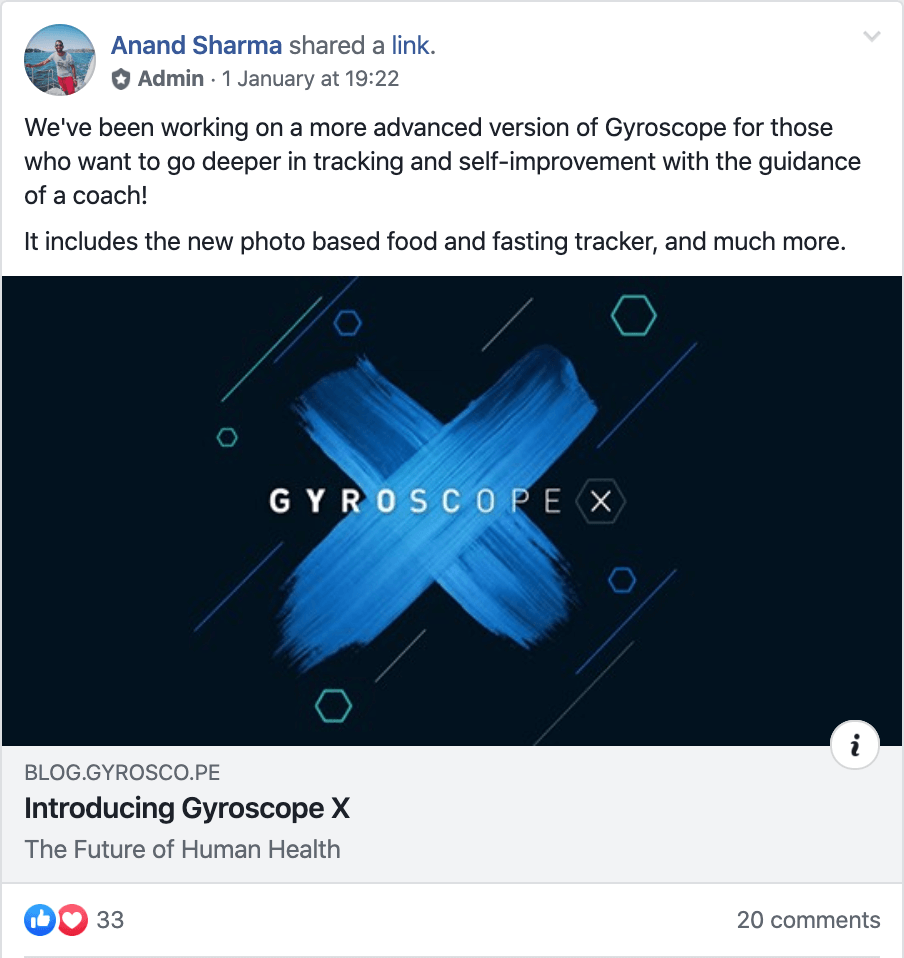
Content to use in this final phase are:
- Exclusive content
- Exclusive communities on Facebook, LinkedIn, or Slack
- Co-creation with your customers to come up with new product ideas
- Special offers and reward programs
- Insider how-to’s
- News and event details
How can Content Marketing help and boost your sales?
Instead of just trying to push your potential customers to buy your product, the sales department of your organization needs to work closely together with your marketing department.
They need to assist in creating attention-grabbing pieces of content to help them better connect with their leads.
However, there are many different ways to help create that value for your prospects throughout the first three steps of the journey.
The parts of the funnel leading up to the sales and even afterward. How can you convert your audience using content, keep them on board, and even turn them into brand advocates?
Let’s have a look at some more practical examples.
Let a lead self-identify their needs
When you urge a lead to buy a product, you’re slowly pushing him away from that product.
People don’t like to be told what to do or not to do.
Instead, try to create a funnel, a pathway, to make your leads believe that they need your product and can’t live without it. Try to sell him or her your idea and your product using content, and let them realize what they are missing.
To be able to do this successfully, you need to go to the core of content marketing:
Content marketing is just solving the same problems that your product solves through media you create and promote.Click To TweetYou need to create content around the customer’s needs and concerns. With this content, you need to entice them to go to your website.
Using drip email campaigns for this process to send ebooks, whitepapers, or training courses to your leads. Using landing pages or in-page forms to convert people to leave their email addresses in exchange for this material.
Making real connections
According to research done by the SalesBenchmark Index, you are 4.2 times more likely to get an appointment with a lead or a lead opting in for a product trial when you have a personal connection with your leads.
What was the last time you made a real personal connection based on some sales call? We’re sure this was never.
Sending more sales pitch emails or stalking them on the phone trying to get that sale will not cut it.
Using the power of storytelling, you can try to forge a connection by sharing something personal and letting your leads relate to you.
Sharing relevant content with your leads after you’ve had them on the phone, using, for example, customer testimonials telling them how their business changed for the better after using your product.
Trying to make it personal by making those real connections can do wonders for your business.
Adding value to the sale
Having that real connection with your prospects brings a lot of value to the sales process.
Traditionally companies did not care about the buyer’s needs. They just wanted to get the sales done and move on to a different prospect. Using “content selling,” you can focus on your buyers’ needs and requirements.
Using highly targeted advertising, using, for example, Facebook Dark Post, you’re able to send your leads highly targeted content that addresses their needs and concerns.
Using a technique like this will give you a headstart when you or your sales team picks up the phone and make the sales call – you’ve already captured their attention with a compelling read.
Using (unique) content to stay on top of mind
In today’s world, there is so much happening simultaneously, so many different brands trying to get the attention of the same type of people you are trying to target. It is only natural that people might quickly forget about you again after they first heard from you.
This results in only a limited opportunity window to follow up and connect with your potential customers and your leads.
Doing this without coming over as annoying can be tricky and tough.
Trying to stay on their radar using (unique) content is key here.
By now, you should already know a bit more about the interests and likes of your prospects. By sharing tips and tricks and knowledge-based content with your leads, you can help them shape your opinion about you.
An opinion of you being a trustworthy company, someone who knows what they are discussing.
Using more formal materials about your product can help you gain a better understanding of your product or service offering to your leads to build trust.
Providing Credibility
The final step before the sales in which content can assist is providing credibility.
When people are ready to buy, it is the credibility of the company that will help people move over their last sets of fear and doubts and buy your product.
To show the credibility of your product or service, you can use articles or videos recorded by your customers talking about how they use your product and how it impacted their business and sent them to your leads.
Even specific content like infographics, white papers, and ebooks published on other websites can help you increase your product credibility in the eyes of your leads.
As long as it is content produced by others, this can be an adamant trigger. Your internal team, of course, can help and assist in creating this content as long as it stays authentic.
Create content that puts your customers in the spotlight
While the above examples are targeted at converting new leads toward customers. What can you do at the moment after the sales to keep them as a client, to turn them into loyal customers and even brand advocates?
If you got customers who are giving their time and energy to interacting with you, suggesting new product ideas, etc. These are the types of people who are already engaged with your brand.
It is very easy to turn them into brand advocates by thanking them publicly and appreciating them in fun ways. How can you say thank you in a unique way? Maybe it could be something as simple as putting their face and story on your website.
Many companies are investing in customer/client sections on their website. Parts of the site where they tell the customer story and say thank you for drawing attention to their cause and story. It is an excellent execution of the reciprocal loyalty philosophy.
As you can see, content marketing can aid and assist sales.
Relevant content can be used to gain the attention of leads and help to gain trust in your company.
Instead of contemplating how to use your limited resources to connect with your leads, look at it from a different angle. Let your sales and marketing team work together to create content for all the steps in the customer’s journey to help get a lead on your side.
Great content alone, however, doesn’t lead to sales.
Providing relevant information just when your sales team needs it can help them engage with their leads more efficiently.
This, in return, will create more sales, and isn’t that what marketing is all about?
So know your audience, understand the pain points and challenges of your potential buyers, develop a sales funnel that’s relevant to your business, and finally develop a content marketing strategy for each stage of the customer’s journey followed with the proper types of content and you’re off to the races.
How are your marketing and sales team delivering value to your prospects? Share them in the comments below so we can all learn from each other!
Want to learn more about growing your business through digital marketing? Looking to take your business to the next level? Let’s talk!
If you want you can easily unsubscribe with a single click at any time.
[…] Understanding your customers, Buyers Journey is crucial if you want to develop strategic marketing t…. Thankfully Google Analytics offers many powerful functions to measure customer behaviour, allowing you to learn from this and respond accordingly. […]
[…] potential customer of your company is somewhere in the Buyers Journey. It would be best to try to set goals that direct your readers all the way through that journey. […]
[…] It is also paving the way for your potential customers to learn more about what you have to offer, getting them interested and educated before they will make the sale. And it is about bonding with them after you made the deal to turn them into ambassadors of your bran…. […]
[…] nurturing, and education of your leads is one of the most compelling aspects of any marketing automation tool. It can help people move […]
[…] some proper buyer persona’s around your ideal customers. All of these personas are located in different parts of their buyer’s journey. This too means that various purposes for emails will create different sets of emails for various […]
[…] Awareness, Consideration, Conversion, Loyalty, Advocacy. The five stages of the Buyer’s Journey. […]
[…] Some even align with the stages of the purchasing process, or customer journey, allowing you to target potential customer…. […]